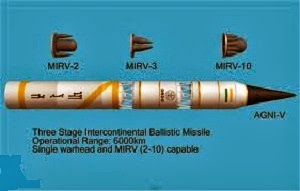It is an intercontinental ballistic missile developed by the Defence Research and Development Organization (DRDO) of India. It is part of the Agni series of missiles, one of the missile systems under the original Integrated Guided Missile Development Program. According to DRDO chief, the exact range of Agni V is "classified" but afterwards he described Agni V as a missile with a range of 5,500-5,800 km. The Agni-V is expected to be operational by 2014 to 2015 after four to five repeatable tests by the DRDO. Indian authorities believe that the solid-fueled Agni-V is more than adequate to meet current threat perceptions and security concerns. The missile will allow India to strike targets across Asia and into Europe.
The missile was designed to be easy to transport by road through the utilization of a canister-launch missile system which is distinct from those of the earlier Agni missiles. Agni-V would also carry MIRV (Multiple Independently targetable Re-entry Vehicles) payloads being concurrently developed.
A single MIRV equipped missile can deliver multiple warheads at different targets.Agni-V will incorporate advanced technologies involving ring laser gyroscope and accelerometer for navigation and guidance. It takes its first stage from Agni-III, with a modified second stage and a miniaturized third stage to ensure it can fly to distances of 5,000 kilometers (3,100 mi). With a canister-launch system to impart higher road mobility, the missile will give the armed forces much greater operational flexibility than the earlier-generation of Agni missiles. According to a source, the accuracy levels of Agni-V and the 3,800-kilometre (2,400 mi) Agni-IV (first tested in November 2011), with their better guidance and navigation systems, are far higher than Agni-I (700 km [430 mi]), Agni-II (2,000 km [1,200 mi]) and Agni-III (3,000 km [1,900 mi]).
The Agni-V is a three stage solid fueled missile with composite motor casing in the second and third stage.
In many aspects, the Agni-5 carries forward the Agni-3 pedigree. With composites used extensively to reduce weight, and a third stage added on (the Agni-3 was a two-stage missile), the Agni-5 can fly significantly more to inter-continental range.
Total flight duration for the first flight test of Agni-V on 29 April 2012 was for 1130 seconds. The first stage ignited for 90 seconds.
MIRVs
Agni-V will feature Multiple Independent Re-entry Vehicles (MIRVs) with each missile being capable of carrying 2–10 separate nuclear warheads.
Each warhead can be assigned to a different target, separated by hundreds of kilometers; alternatively, two or more warheads can be assigned to one target.
MIRVs ensure a credible second strike capability even with few missiles.
The missile will utilize a canister and will be launched from it. Made of maraging steel, a canister must provide a hermetically sealed atmosphere that preserves the missile for years. During firing, the canister must absorb enormous stresses when a thrust of 300 to 400 tonnes (300 to 390 long tons; 330 to 440 short tons) is generated to eject the 50 tonnes (49 long tons; 55 short tons) missile.
India has successfully test-fired Agni-V, its first Inter-Continental Ballistic Missile (ICBM). Agni-V is capable of reaching deep into Asia and Europe, a move that would bring the emerging power into a small club of nations with intercontinental defense capabilities. India has a no-first-use policy and says its nuclear weapons and missiles are for defensive purposes only. proud to be an Indian.





(AGNI-Vmissile,with a range of 5,000 km (3,100 miles), successfully lifts off from Wheeler ’s Island of India’s east coast in Odisha.) However, China’s strategic experts and the officialmedia are trying to provokewestern countries saying the Agni-V missile has a longer range than India would admit, and it can hit cities in Europe. In comments that are obviously authorized by the defence ministry, Chinese experts said the Indian missile actually has a range of 8,000 kilometers and not the shorter range of 5,000 kms, as claimed by India. There are signs China will try to pressure the US and Russia not to sell missile guidance systems to India.
ReplyDeleteIndia’s military research has failed to come up with unique solutions. In conventional military spend, India would never be able to match up to China and other global powers. While US spent 45.7% of the global military expenditure last year, China was second at 5.5%. India isway below at just 2.3%. China is galloping ahead, and is estimated to overtake the US by 2035. A military strategy, to protect its autonomy and economic growth, cannot be mere development of longer-range missiles or other conventional weapons. It has to be unconventional technological leap, of achieving capabilities within the limited resources available. That would call for determined efforts to bring in domestic industries and revamping of military research. That means a really radical change. This would require a firm political leadership, something the UPA government has failed to exhibit so far. Agni V isn’t fiery enough for India.
ReplyDelete